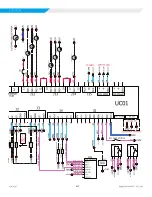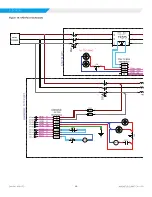
7
IOM 1297
WWW.DAIKINAPPLIED.COM
INSTALLATION
Figure 3: Illustration of Allowed Angle Label
Lifting Equipment
Lifting equipment is supplied by the user or their designate.
This is typically selected around the unit certified information
of the equipment to be lifted and the available lifting equipment
planned to be at the site where the lift is to take place. It is the
responsibility of the Lifting Director to follow a standard practice
of lift planning and equipment selection, like that found in the
ASME P30 series of standards. Lifting plan and equipment must
ensure that the only contact with the unit is at that lifting brackets.
Straps, chains or spreader bars that are likely to be used shall
not come in contact with the unit.
CAUTION
Lifting mechanisms must not make contact with the unit beyond the lifting
bracket. Extreme care must be used when rigging the unit to prevent damage
to the control panels, unit handles, and unit frame.
Lifting Points
Lifting points are predetermined by design. When lifting, all
factory installed lifting brackets must be used.
typical 4 point and 6 point lifting configurations. Unit must remain
level throughout the entire lifting event. Level is defined as
one end being no more than 0.25” per foot of unit length to the
opposite end.
WARNING
Be aware that the center of gravity may not necessarily be in the geometric
center of the unit. No additional items can be added to a lift with the unit as
it may affect the center of gravity and cause unit damage, property damage,
severe personal injury, or death. Refer to as-designed, certified drawings for
weight, center of gravity location and details specific to unit configuration.
Figure 4: Typical Lifting Points Locations
Transit and Temporary Storage
If the unit is stored for an intermediate period before installation
or moved to a different location, take these additional
precautions:
1 .
Support the unit well along the length of the base rail.
2 .
Level the unit (no twists or uneven ground surface).
3 .
Provide proper drainage around the unit to prevent flooding
of the equipment.
4 .
Provide adequate protection from vandalism, mechanical
contact, etc.
5 .
Securely close the doors and lock the handles
6 .
Cover the supply and return air openings on units without
isolation dampers.
7 .
Long term storage in humid environments may cause
condensate corrosion on steel surfaces. Consider adding a
desiccant material to alleviate corrosion concerns.
Long Term Storage
This information applies to new units being stored waiting for
startup or existing units that may be inoperative or in storage for
four
months or more.
The chiller must be stored in a secure, dry location and protected
from any damage or sources of corrosion while in storage. A
Daikin Applied service representative must perform a leak test
and visual inspection for any damage or unusual conditions
affecting the unit on a minimum quarterly schedule, to be paid
by the owner or contractor. Daikin Applied will not be responsible
for any refrigerant loss during the storage time, for repairs to
the unit during the storage period, or while moving the unit from
the original location to a storage facility and back to any new
installation location. If there is concern about the possibilities of








































